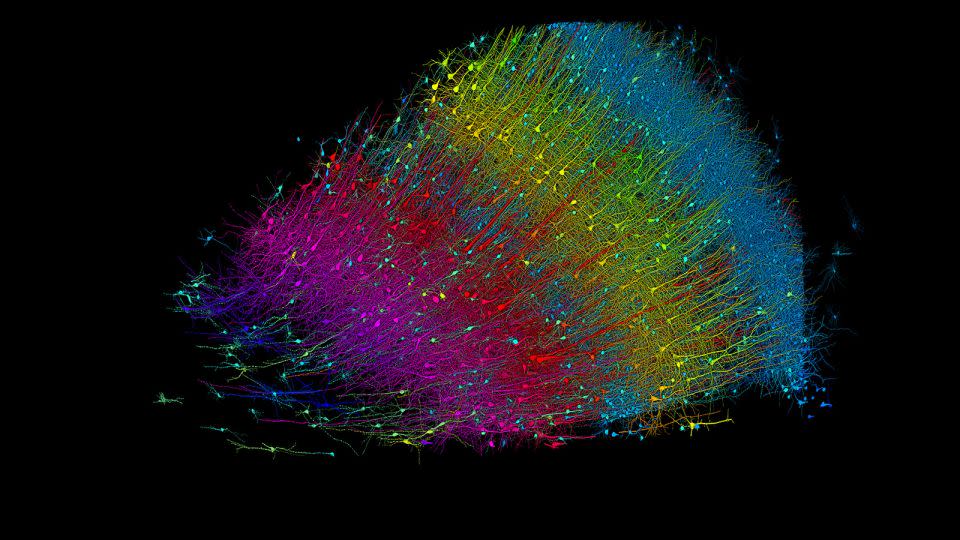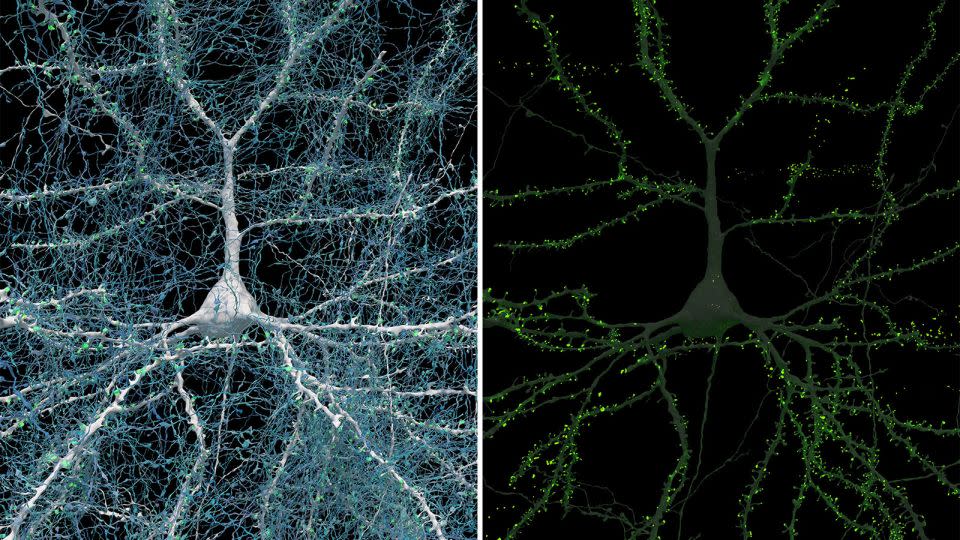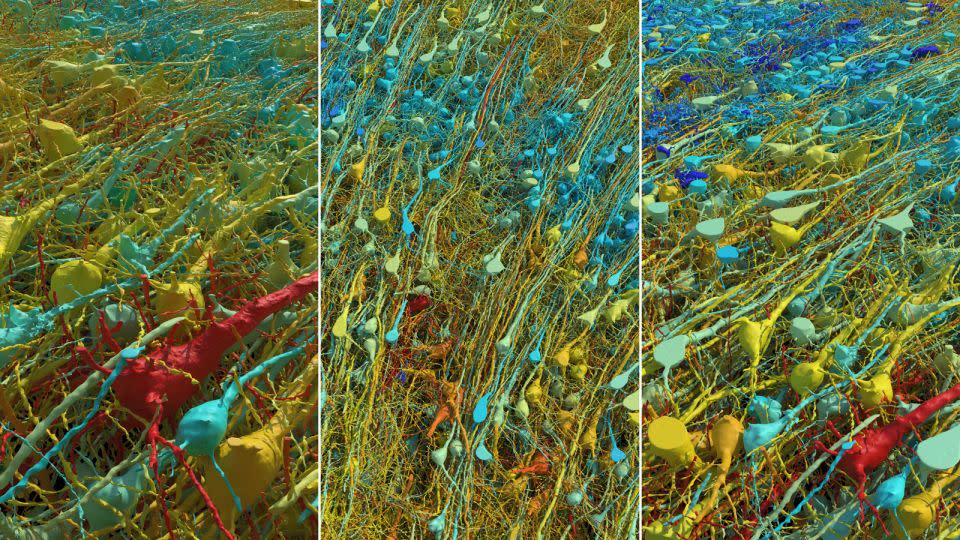Google and Harvard unveil most detailed ever map of human brain
Sign up for CNN’s Wonder Theory science newsletter. Explore the universe with news on fascinating discoveries, scientific advancements and more.
Ten years ago, Dr. Jeff Lichtman — a professor of molecular and cellular biology at Harvard University — received a small brain sample in his lab.
Although tiny, the 1 cubic millimeter of tissue was big enough to contain 57,000 cells, 230 millimeters of blood vessels and 150 million synapses.
“It was less than a grain of rice, but we began to cut it and look at it, and it was really beautiful,” he said. “But as we were accumulating the data, I realized that we just had way, way more than we could handle.”
Eventually, Lichtman and his team ended up with 1,400 terabytes of data from the sample — roughly the content of over 1 billion books. Now, after the lab team’s decade of close collaboration with scientists at Google, that data has turned into the most detailed map of a human brain sample ever created.
300 million images
The brain sample came from a patient with severe epilepsy. It’s standard procedure, Lichtman said, to remove a small portion of the brain to stop the seizures, and then look at the tissue to make sure it’s normal. “But it was anonymized, so I knew next to nothing about the patient, other than their age and gender,” he said.
To analyze the sample, Lichtman and his team first cut it into thin sections using a knife with a blade edge made of diamond. The sections were then embedded into a hard resin and sliced again, very thinly. “About 30 nanometers, or roughly 1,000th of the thickness of a human hair. They were virtually invisible, if it weren’t for the fact that we had stained them with heavy metals, which made them visible when doing electron imaging,” he said.
The team ended up with several thousand slices, which were picked up with a custom-made tape, creating a sort of film strip: “If you take a picture of each of those sections and align those pictures, you get a three-dimensional piece of brain at the microscopic level.”

That’s when the researchers realized they needed help with the data, because the resulting images would take up a significant amount of storage.
Lichtman knew that Google was working on a digital map of a fruit fly’s brain, released in 2019, and had the right computer hardware for the job. He got in touch with Viren Jain, a senior staff research scientist at Google who was working on the fruit fly project.
“There were 300 million separate images (in Harvard’s data),” Jain said. “What makes it so much data is that you’re imaging at a very high resolution, the level of an individual synapse. And just in that small sample of brain tissue there were 150 million synapses.”
To make sense of the images, scientists at Google used AI-based processing and analysis, identifying what type of cells were in each picture and how they were connected. The result is an interactive 3D model of the brain tissue, and the largest dataset ever made at this resolution of a human brain structure. Google made it available online as “Neuroglancer,” and a study was published in the journal Science at the same time, with Lichtman and Jain among the coauthors.
Understanding the brain
The collaboration between the Harvard and Google teams resulted in colorized images that make the individual components more visible, but they are otherwise a truthful representation of the tissue.
“The colors are completely arbitrary,” Jain explained, “but beyond that, there’s not much artistic license here. The whole point of this is that we’re not making it up — these are the real neurons, the real wires that exist in this brain, and we’re really just making it convenient and accessible for biologists to view and study.”
The data contained some surprises. For example, rather than forming a single connection, pairs of neurons instead have more than 50. “This is kind of like if two houses on a block had 50 separate phone lines connecting them. What’s going on there? Why are they so strongly connected? We don’t know what the function or significance of this phenomenon is yet, we’re going to have to study it further,” he said.
Eventually, observing the brain at this level of detail could help researchers make sense of unresolved medical conditions, according to Lichtman.
“What does it mean to understand our brain? The best we may be able to do is describe it, and hope that from these descriptions will come a realization, for example, about how normal brains are different from brains that are disordered, in adult psychiatric diseases or developmental disorders like the autism spectrum — that kind of comparison will be very valuable,” he said. “Eventually, it will give us some insight into what’s wrong, which, in most cases, we’re still in the dark about.”
Lichtman also believes that the dataset may be filled with other amazing details that, because of its size, haven’t been discovered yet: “And that’s why we’re sharing it online, so anyone can look at it and find things,” he added.

Next up, the team behind the project aims to create a full map of the brain of a mouse, which would require between 500 and 1,000 times the amount of data of the human brain sample.
“That would mean 1 exabyte, which is 1,000 petabytes,” Lichtman said. “A lot of people are thinking hard about how we’re going to do this, and we’re in the first year of a five-year proof of principle. I think that would be a watershed moment for neuroscience, to have a complete mammalian brain’s wiring diagram; it would answer many, many questions. And of course, it would reveal many more problems, things we hadn’t expected.”
What about mapping an entire human brain? That would be another 1,000 times bigger, Lichtman explained, which means the data would amount to 1 zettabyte. In 2016, that was the size of the entire internet traffic for the year, according to Cisco. At the moment, Lichtman said, it would not only be difficult to even store that much data, but there would be no ethically acceptable way of sourcing a pristine, well-preserved human brain.
Breaking new ground
Researchers in the same field who were not involved with the work expressed their enthusiasm when approached by CNN for comment.
“This study is wonderful, and there is so much to learn from data like this,” said Michael Bienkowski, an assistant professor of physiology and neuroscience at the University of Southern California’s Keck School of Medicine.
“Much of what we think we understand about the human brain is extrapolated from animals, but research like this is critical for revealing what truly makes us human. Visualizing neurons and other brain cells is really challenging due to their sheer density and complexity, and the current dataset does not capture the longer-range connections,” Bienkowski said.
“What other brain regions are these inputs originating from, and where do the outputs go once they leave the area? But to see all these different cell types and their interactions is incredible and makes you appreciate what a masterpiece of architecture life has given us,” he added.
Andreas Tolias, a professor of ophthalmology at Stanford University in California, agreed. “This is a remarkable technical study that reconstructs the structure of the human cortex at high resolution,” he said. “I was particularly excited about the discovery of rare axons capable of forming up to 50 synapses. This finding is intriguing and raises important questions about their computational roles.”

The brain-mapping project opens the door for future investigations, according to neuroscientist Olaf Sporns.
“Each human brain is a vast network of billions of nerve cells,” said Sporns, distinguished professor of psychological and brain sciences at Indiana University. “This network allows cells to communicate, in very specific patterns that are fundamental for memory, thought, and behavior. Mapping this network, the human connectome, is critical for figuring out how the brain works,” he added, noting that the study breaks new ground toward this important goal, and offers exciting new opportunities for exploration and discovery.
For more CNN news and newsletters create an account at CNN.com

